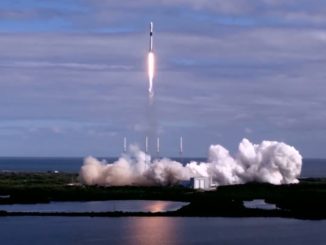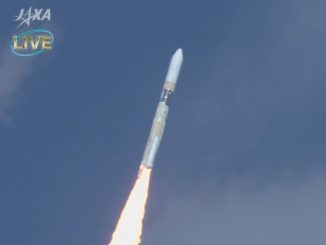
SpaceX says engineers completed checks of the Falcon Heavy rocket, its satellite payloads, and ground systems at the Kennedy Space Center after a lightning strike on the launch pad’s tower Thursday night, part of a wave of severe weather that forced officials to delay the launch attempt.
The countdown for the Falcon Heavy launch was scrubbed Thursday due to severe weather around NASA’s Kennedy Space Center, which included lightning and a tornado warning. The liftoff was rescheduled for no earlier than Friday at 7:29 p.m. EDT (2329 UTC), the opening of a 57-minute launch window.
Cameras around the launch pad captured views of lightning hitting the lightning protection mast on top of the fixed tower at pad 39A. The lightning mast is designed to divert electrical charges down catenary wires to the ground, and away from a rocket standing on the launch pad. The system appeared to work as intended.
Here’s a video of that lightning strike at the Falcon Heavy’s launch pad. pic.twitter.com/YOe9a9AwQW
— Spaceflight Now (@SpaceflightNow) April 28, 2023
The Falcon Heavy rocket is awaiting liftoff with the ViaSat 3 Americas broadband satellite, a high-power spacecraft heading to geostationary orbit to beam internet signals to rural consumers, airplane passengers, and ships across North and South America. It is the first of three new Boeing-built satellites to extend Viasat’s internet coverage from the Americas to new markets in Europe, Africa, the Middle East, and the Asia-Pacific region.
Two small rideshare payloads for Astranis and Gravity Space will hitch a ride on the Falcon Heavy rocket to a near-geosynchronous orbit more than 20,000 miles (about 35,000 kilometers) over the equator. The Falcon Heavy’s launch profile to the high-altitude orbit is a demanding one, requiring all of the rocket’s propellant and eliminating any chance to recover the rocket’s three first stage boosters.
The ViaSat 3 Americas mission will be the sixth flight of a SpaceX Falcon Heavy rocket.
Stormy weather could again be a problem Friday night, with the official forecast predicting a 70% chance of weather violating the Falcon Heavy’s launch criteria. The main weather concerns are with anvil clouds and the risk of lightning.
“Friday will be another active day as an area of low pressure tracking across the Mid-South pulls a frontal boundary into Florida,” forecasters from the U.S. Space Force’s 45th Weather Squadron wrote in their outlook. “The boundary will bring activity moving from west to east towards the spaceport by midday and continuing through the afternoon. Most activity may be just south or offshore of the spaceport by the start of the backup window but given current uncertainty would expect at least lingering debris clouds and anvils through the window.”
The stormy weather is expected to continue Saturday.
SpaceX is also planning to launch a Falcon 9 rocket Friday afternoon from nearby pad 40 at Cape Canaveral Space Force Station with a pair of satellites for the O3b mPOWER internet network owned by SES, a Luxembourg-based satellite operator. The Falcon 9 / O3b mPOWER mission has a launch window opening at 5:12 p.m. EDT (2112 UTC), but the storms forecast for Central Florida also threaten to delay that launch.
Email the author.
Follow Stephen Clark on Twitter: @StephenClark1.



